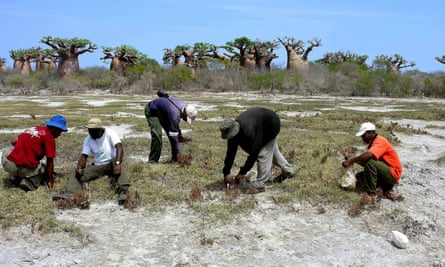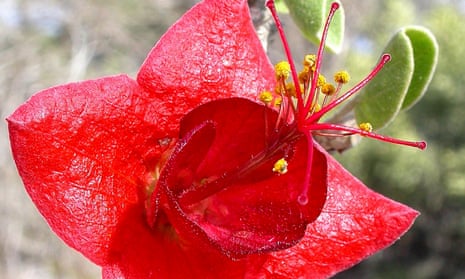Scientists are racing against time to create a backup of Madagascar’s famously rich and varied flora in a British seed bank before it is lost forever.
The Indian ocean country is known as a biodiversity hotspot with 13,000 plant species, 90% of which are unique to the island and found nowhere else on Earth.
But while its forests are still yielding species new to science, they are increasingly under pressure from farmers who see the forests as their only resource. Many people live on less than a dollar a day and poverty has got worse since aid was cut off following a military coup seven years ago, leading to widespread forest clearance.
“It’s getting worse and worse [the slash and burn clearances], the poverty in Madagascar is increasing,” said Solofo Eric Rakotoarisoa, a team leader in Madagascar for Kew Gardens.
Rakotoarisoa leads half a dozen forays into the country’s wilds each year, which often take several days to reach and can involve overcoming submerged roads as rivers flood, to collect seeds of threatened and economically important plants. “It’s getting to the point where it’s really obvious the forests are disappearing,” he warned.

Once his team of 20 has methodically sorted and labelled the seeds of aloes, baobabs and other plants, they are quickly flown via DHL to the UK for safeguarding at Kew’s millennium seed bank.
Nestled in the bucolic grounds of Wakehurst Place, a country house in West Sussex, the bank is an ultimate insurance policy for the world’s wild plants, with an underground vault worthy of James Bond to keep them safe. Kew aims to bank 25% of the world’s plants by 2020, and is at 13% so far.
Of those in the freezer already, 1,800 species are from Madagascar but botanists think a total of 6,000 of the island country’s 13,000 plants could successfully be dried and stored here. The other 7,000-odd are recalcitrant seeds, including those of palms from humid forests in the east of the country, which do not survive the drying and freezing process.
“It’s a race against time, picking these things up for the seed bank. It’s insurance against extinction,” said Stuart Cable, head of the Kew Madagascan Conservation Centre. He estimates that around 70% of Madagascar’s plants are endangered.

Here in air-conditioned labs in the English countryside, technicians are sorting through more than 100 seeds recently delivered from Madgascar. On arrival, each bag gets a serial code and barcode before the seeds begin their journey toward the freezer.
Seeds are cut and handpicked from seed heads, sieved, cleaned and x-rayed with a £60,000 machine to see how healthy and viablethey are. Designed for hospital use, the machine’s system asks for the seed’s patient name and gender when they’re logged.
Moisture is the enemy at the bank. “If we put a damp seed into the freezer it will die,” says Tim R Pearce, conservation partnership coordinator for Africa at Kew, as he stands in a drying room where moisture is sucked out until the seeds reach the gold standard of 15% relative humidity.
Once suitably desiccated, they are sent downstairs to the vault, which is protected by reinforced concrete and considered bombproof and plane-crash-proof. Here they are stored at -20C in jam jars with metal clasps, ready to be germinated and returned to the wild in the future.
Eventually, Rakotoarisoa and Cable hope that the rest of Madagascar’s plants will join them in the bank’s cold storage. The next phase of the seed collection involves a big scaling-up of Kew’s efforts, using a £200,000 project to create an army of people in rural communities to help collect seeds and conserve forests in Madagascar.

Comments (…)
Sign in or create your Guardian account to join the discussion